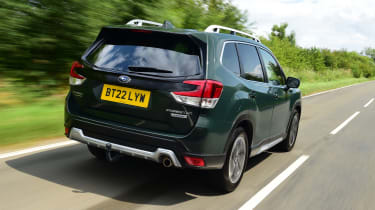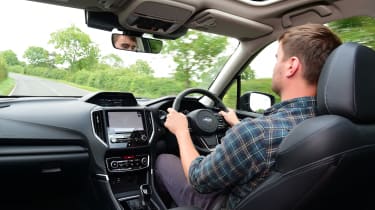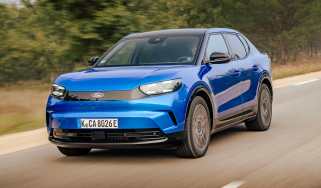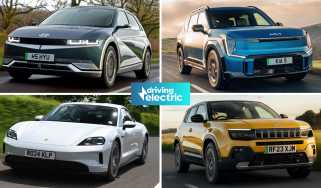Subaru Forester hybrid review
The all-wheel-drive Subaru Forester e-Boxer hybrid is great off-road and comfortable on-road, but its price is quite hard to justify
Pros
- Great off-road capability
- Comfortable driving position
- Masses of safety equipment
Cons
- Not economical
- Pretty expensive
- Weak performance
| Car type | Fuel economy | CO2 emissions | 0-62mph |
|---|---|---|---|
| Hybrid | 34.7mpg | 185g/km | 11.8s |
The Subaru Forester seems like the complete antithesis of the electric revolution, but it's actually now exclusively powered by the brand's 'e-Boxer' hybrid system, giving this rugged off-roader some electrification without the need to plug it in.
This latest Forester has a sharper front-end look, with new headlights and a revised grille. In addition, the safety tech now includes automatic emergency steering, adds a lane-centring function to the adaptive cruise control, and brings lane-departure prevention that recognises the road edge and grass verges.
What remains is this vehicle's USP of having the additional traction of permanent four-wheel drive, which should please any jobbing vet who has to drive up a muddy farm track. There's also a decent 8.6 inches of ground clearance and a dedicated off-road mode, so you should get places most road-biased SUVs can't.
The hybrid system on the Forester is ’self-charging’, with minimal pure-electric range because of a tiny 0.57kWh battery, and while there is an 'EV mode' button to force the car to use electricity alone, it doesn't have the performance to keep up with traffic before the engine jumps in.
That engine has only 148bhp from its 2.0-litre engine and electric motor combination, so 0-62mph takes a leisurely 11.8 seconds. For reference, a similarly priced Kia Sportage hybrid has 223bhp and takes only 7.7 seconds to get to 62mph.
You're unlikely to drive the Forester as enthusiastically as a rally-bred Subaru Impreza of the ’90s, but it would be nice if Subaru's e-Boxer hybrid system were more pleasant to use in everyday driving. It tries to get moving under electric power but can’t sustain this for long and has to start the engine. Unfortunately, when it takes over, it does so with a jolt that's out of step with the seamless experience you'll find in a Toyota hybrid. The Forester's engine is unrefined, and that's made worse by the CVT automatic gearbox, which keeps the revs high when accelerating. Fuel economy and emissions are worse than a Toyota hybrid’s; the Forester returns only mid-30s to the gallon and is in the highest 37% company car tax bracket.
It's not all bad news because the Forester rides well, whether over potholes at low speed or expansion joints on the motorway. Body lean in corners isn't excessive, and it grips the road well enough that you can maintain a decent speed on a twisty B-road: helpful because it'll take effort to build your momentum back up again if you have to brake. The steering isn't as quick as a Ford Kuga’s nor as well weighted as that in the Sportage, but it's precise enough for an SUV.
Space inside is also a plus point thanks to the boxy shape of the Forester, so there's plenty of head or legroom for a six-footer, whether they're in the front or the back. The boot isn't quite as big as its rivals, but it is still a usefully square shape and has a low-loading lip to make it easy to load heavier items.
On top of that, the Forester is a well-liked choice with owners, according to our Driver Power survey. Read the rest of our Subaru Forester review to find out what people liked about it and how it compares with rivals…





